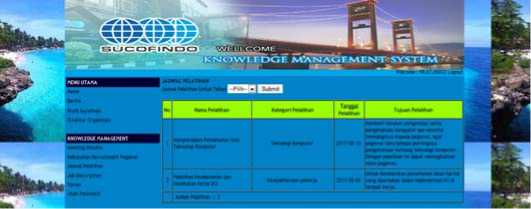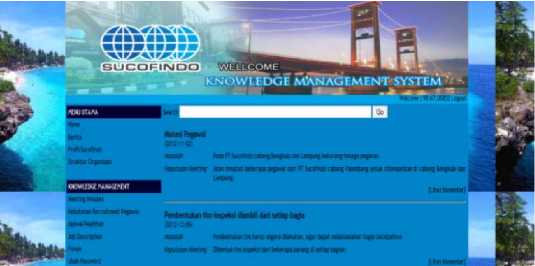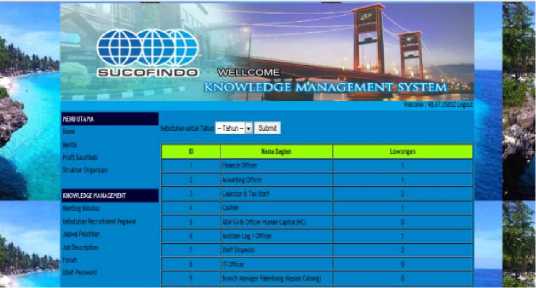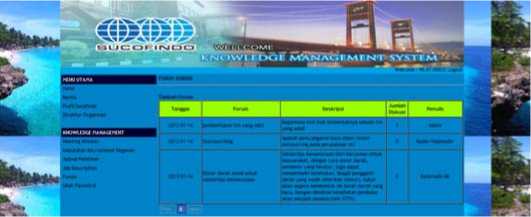Knowledge Management Systems Analysis and Planning for Employees Recruitment and Training
on
38
Journal of Electrical, Electronics and Informatics, p-ISSN: 2549–8304 e-ISSN: 2622–0393
Knowledge Management System Analysis and Planning For Employee Recruitment and Training
Tri A. Purwanto1, Leon A. Abdillah2*, and Eka P. Agustini3
1-3Department of Information Systems
Universitas Bina Darma (UBD)
Palembang, Indonesia leon.abdillah@yahoo.com
Abstract The development of science in the era of globalization is happening so quickly. The ability of humans to develop a variety of science (knowledge) is getting better with the tacit and explicit knowledge. From this development both tacit and explicit knowledge can be combined and varied to a Knowledge Management System. PT SCF (Limited) Palembang branch is a company engaged in the field of inspection and certification services. The problem faced by this company is that the process and media for sharing and transferring knowledge between colleagues is still small and not yet entrenched. This condition makes the company less effective in terms of producing and disseminating knowledge to staff quickly and accurately. Documentation of daily activities and routines are not carried out in a planned and integrated manner. Each department carries out its own activities in its own way, for example storing documentation on a CD, as well as a piece of paper. So, the authors are interested in analyzing and designing Web Knowledge Management System. The methods used were the object analysis and design method. While the tools for modeling used was Unified Modeling Language (UML). The result obtained is a prototype web Knowledge Management System (KMS) that can be a media of information and knowledge sharing related to employee acceptance and training.
Index Terms— Employee recruitment, Employee training, KMS, OOA&D, UML.
Information Technology (IT) is a collection of hardware, software, and brain ware equipment to process data into information for various needs/goals within the limits of space and time [1]. The extraordinary advantages of IT, it should be utilized by various parties to manage various institutional activities well, planned and documented to the maximum [2] so that it can improve its competitiveness.
A good system of documentation and development of human resources (HR) are 2 (two) things that are considered important by the company to increase competitive competitiveness. In order to make the organization competitive, managers must place knowledge as a driving force for the organization [3].
In organizations, knowledge is obtained from individuals or groups of people who have knowledge through structured media. One of the media that is able to provide a very large effect on knowledge for managers is through information technology [4], for example is a web of knowledge management system.
For the human resource (HR) field itself, IT has been
applied to various phases related to the HR flow, such as the calculation of honorarium [5], payroll payment [2], and lecturer performance [1]. A number of articles also discuss knowledge sharing cultures [4, 6]. Knowledge Management (KM) division [7] can also be created in an organization. However, in this article, the author will discuss the use of IT in recruitment and training of employees.
Nonaka identified 4 (four) main knowledge conversions into four dimensions known as "SECI" [8]: 1) Socialization, 2) Externalization, 3) Combination, and 4) Internalization. These four dimensions will take place into cycles that are expected to move knowledge.
PT SCF is a company engaged in the field of inspection or checking services. Inspection or checking is something that must be done to guarantee the quality as expected. The results of the inspection or checking will produce good products, products that can still be reworked and products that fail or products that do not pass the inspection or checking.
The HR division at PT SCF consists of four parts: 1) staff, 2) assistant officer, 3) human capital officer, and 4) business support department. Each section has its own
tasks. The staff section is in charge of data entry on health insurances, overtimes, leaves, permits and "Surat Perintah Perjalanan Dinas" (SPPD). The assistant officer has the duty to input salary data, social security data, and PPH 21 (income tax). The human capital (HC) officer has the task of verifying the reports or correcting every report that has been made by the staff and assistant officers.
However, the problem faced by this company is the absence of a process of sharing and transferring knowledge between fellow employees is also still relatively rare, so that employees often experience self-struggle when faced with big problems. The company's documentation system is perceived to be less effective which is able to produce knowledge for employees quickly and accurately. Documentation of daily routine activities has not yet been carried out in an integrated manner, each part in its own way storing documentation such as being stored on CDs or sheets of paper. Whereas the knowledge that has been transferred and recorded should be stored in the organization, if at any time it is needed, it can be searched easily [3].
In addition, mutations, rotations, and pensions cause the knowledge held in the HR department to move to another place. This resulted in the occurrence of knowledge loss which is a condition where companies lose the required knowledge.
This condition reflects that the condition of knowledge management at PT SCF HR has not been well conceptualized so that it has not yet provided positive benefits for each other. With good management, many benefits can be learned, for example regarding the management of a particular field of expertise, career development, and so on. To realize this, the habit of writing and publishing must be cultivated. In addition, knowledge management systems are also needed as a place for employees to publish ideas or research results. In addition, a forum for responding to (discussion) topics that have been posted by employees must also be available. Such organizational knowledge management systems are known as the Organization Knowledge Management System (OKMS) [9]. Basically the knowledge management process includes 4 (four) main functions, namely: 1) using knowledge (use of knowledge), 2) finding knowledge (knowledge discovery), 3) creating knowledge (knowledge making), and 4) packaging knowledge.
Therefore, to manage that knowledge, a knowledge management application is needed as a supporting tool to improve the performance of employees at PT SCF in the HR department. The knowledge application that will be designed has a purpose to manage and disseminate knowledge so that it can be used in order to facilitate the flow of information within the company so that it can be well distributed and can be used to increase the knowledge of employees within the company.
To prevent the discussion from spreading, and to provide more targeted discussions, the research carried out was
limited to discussions relating to the HR department, especially employee recruitment and employee training.
This section discusses: 1) Research Location and Duration, 2) Data Collection Method, 3) System Development Method, 4) Class Diagrams, and 5) Database Design.
-
A. Research Location and Duration
The time needed to complete this study was 5 (five) months. The location where the writer conducts the research was the branch of the national company which is located in one of the protocol streets in Palembang International City.
-
B. Data Collection Methods
To gather the data that was needed in this study, the authors did the following things carefully: 1) Observation: observation and recorded directly to collect data on PT SCF HR department, 2) Interview: asked directly to the HR department at PT SCF includes: a) the head of business support, b) human capital officer, c) assistant officer, d) staff in providing information about PT SCF data, and 3) Literature: finding and studying employee data at HR of PT SCF, as well as from books relating to PT SCF or from other references related to this study.
-
C. System Development Method
Development method is compiling a new system to replace the old system as a whole or improve the existing system. The method used was the Object Oriented Analysis and Design (OOAD) method. OOAD method is an analysis method that checks requirements from the perspective of classes and objects encountered in the scope of the problem that directs software architecture based on manipulation of system objects or subsystems.
The object-oriented analysis method used in this study was the Unified method [10, 11]. The following stages of object-oriented analysis used were: 1) guided by the needs of the system user, 2) identifying the use-case usage scenario, 3) selecting classes and objects using needs as the guide, 4) identifying the attributes and operations for each object class, 5) defining the structure and hierarchy of classes, and 6) building a class or object connectedness model.
Objects are abstractions and things that represent the real world such as objects, humans, organizational units, places, events, structures, status, or other things that are abstract. The object is an entity that is able to store information (status) and have operations (behavior) that can be applied or can affect the status of the object. A class is a collection of objects with the same characteristics. Class is a static definition and the same set of objects that might be born or created and that class.
Based on the analysis obtained a number of objects
involved, namely: 1) Employees, 2) Leaders, 3) Admin, 4) News, 5) News comments, 6) Sections, 7) Meeting minutes, 8) Meeting comments, 9) Employee recruitment needs, 10) Recruitment of employees, 11) Training schedules, 12) Trainings, 13) Forums, 14) Forum topics, and 15) Reply topics.
(logical design), and 3) design physical database (physical design), then a database that has a number of tables is generated as in Table 1.
TABLE I
Units for Magnetic Properties
D. Class Diagram
Object is a representation of the existence of something from the real world (both abstract and real) that has names, properties, and events (can also be added to contain methods) [12]. A class was used as the template to define the methods and variables for a specific object. Class diagram is a diagram used to display several classes and packages in the software system that is being developed. In this study, the authors produced 21 classes (Figure 1).
Komentar Meeting idkomentar idmeeting
. npp tanggal komentar
input() edit() simpan() hapus()
lihat()
hapus()
Mengin
input() simpan()
*input() simpan()
Pimpinan username password akses npp nama tmplahir tgllahir pendidikan bagian
1
1
1
1
menginput() melihat() mengakses() simpan() ubahpassword()
1
1
1
1
1
Berita
idberita judul penulis l tglinput
idkategori
1
1
Forum
idforum namaforum deskripsi
Fig. 1. Class Diagram.
Admin
sername assword
menginput() mengubah() menghapus() ubahpassword()
Pegawai username password akses
nama tmplahir tgllahir bagian
menginput() melihat() simpan() mengakses() ubahpassword()
Mengakses
Mengin
lihat
Melihat
input() edit() simpan() hapus()
Recruitment Pegawai id nama jk tempatlahir tgllahir goldarah kota notlp pendidikan email tglrekam alamat
input() simpan() dit() apus()
Kebutuhan Recru Pegawai
: id
lnamabagian lowongan
lihat()
Data Pegawai npp nama
tmplahir tgllahir agama goldarah pendidikan bagian
Topik Forum idtopik idforum perihal pesan tanggal npp
*input() simpan()
input() edit() simpan() hapus()
E. Database Diagram
Database is a system consisting of a collection of files (tables) that are interconnected in a database in a computer system that allows to access and manipulate the files (tables). There are several criteria [13] relating to databases, namely: 1) are data oriented, 2) consist of connected tables, 3) can be used for sharing, 4 ) minimal redundancy, 5) stored on electronic media, and 6) can develop easily (contents or structure).
After going through a database design method [14] which consists of: 1) database design conceptually (conceptual scheme design), 2) database design logically
|
No |
Table |
Fields |
Remarks |
|
1 |
Users |
3 |
Username data, passwords, and |
|
access | |||
|
2 |
Departments |
2 |
Storing departments’ data in HR division |
|
3 |
Division |
2 |
Storing Divisions’ data |
|
4 |
Employee Recruitment |
12 |
Storing employee recruitment data |
|
5 |
Training |
6 |
Storing employee training data |
|
6 |
Training Category |
2 |
Storing data of training categories |
|
7 |
News |
7 |
Storing news data |
|
8 |
News Category |
2 |
Storing data of news categories |
|
9 |
News Comment |
5 |
Storing data of news comments |
|
10 |
Job description |
5 |
Storing job description data |
|
11 |
Employee |
8 |
Storing staff data |
|
12 |
Meeting minutes |
5 |
Storing meeting minutes data |
|
13 |
Meeting Comment |
5 |
Storing data of meeting comments |
|
14 |
Forum |
5 |
Storing forum discussion data |
|
15 |
Forum Topic |
6 |
Storing data of topic forums |
|
16 |
Topic reply |
5 |
Storing topic reply data |
After analyzing the system, the system design ended with making a prototyping program, the results achieved by the author were a prototyping knowledge management system website that was created and compiled using the PHP programming language and MySQL database.
This website knowledge management system prototyping is useful to help the HR division manage, collect, store, disseminate and utilize knowledge, and reuse it. Furthermore, existing knowledge within the company can be distributed, so that there are facilities to share knowledge among documented fellow employees. With the prototyping of this website, it is hoped that it can help employees to obtain the information and knowledge needed.
-
A. Main Menu
The main menu page is the first page that contains news about the company or about news related to the company (Figure 2). This page is also the entrance to a number of sub menus that have been prepared. In the homepage, there are a company logo and a landmark of Palembang city, The Ampera Bridge. The main page color of the website is dominated by blue.

D. Training Schedule
Fig. 2. The Main Menu.
One of the important services in HR is related to training. The training schedule menu page is used to view the schedule of any research plan in the company. Figure 5 shows the training schedule menu.

Fig. 5. Training Schedule.
E. Discussion Forum
-
B. Meeting Minutes
The meeting minute’s menu page is a page that contains a list of knowledge about the minutes of meetings in the company. With this menu, every minute of the meeting will be well documented and can be used by all parties who need it. Figure 3 show the meeting minute’s menu.

Fig. 3. Meeting Minutes Menu.
-
C. Employee Recruitment Needs
The employee recruitment needs menu page is a user
page. If user wants to check the employee recruitment
needs in the coming year then user can check in through this menu. Figure 4 shows employee recruitment needs menu. Employee needs for each section will be announced
and equipped with the number of needs.

Fig. 4. Employee Recruitment Needs.
The discussion forum menu page is a user page if the user wants to see a list of available forums. In the
discussion forum, users can access the forum if the user
wants to add new topic discussions, so that they can share and exchange knowledge between employees. Figure 6 shows discussion forum menu. Every discussion will be posted and stored in the KMS and is equipped with information related to the forum name, description, number of discussions, and who the author is.

Fig. 6. Discussion Forum.
-
F. Research Contribution
This research enriches a number of previous studies, such as: 1) The Role of Learning Culture and Knowledge Management on Company Performance [15]. PT XYZ has started to recruit new employees through socialization (transfer tacit knowledge)training in the form of practical work with a mentor, and 2) Decision support information system for employee acceptance using Analytical Hierarchy Process (AHP) Method [16]. If the admission process is managed with the concept of knowledge management, the new employee recruitment system will be better and 3) Strategic positioning of HRM in knowledge-based organizations [17]. The Knowledge Management Systems provide the creation and sustain environment for an organization that support innovation, creativity and learning as well as 4) connecting human resources management and knowledge management (18). This research provides the mutual connection between knowledge management and human resource, and 5) an intellectual capital perspective
of human resource strategies and practices (19). The human resources department is responsible for providing labor that is reliable and in accordance with organizational needs and optimally managing the intellectual development of capital (both current and future needs).
Based on the research that has been done, it can be concluded several things as follows: 1) This research produces an object oriented analysis and design of making knowledge management system website with Unified Modeling Language (UML) tools. 2) This research produces a prototype of a knowledge management system website that helps manage information, such as entry, updating, storing, and documenting knowledge that is useful for the company and disseminating information to all employees of PT SCF especially in the HR department. 3) This research also produces a prototype of the website knowledge management system in the form of a knowledge that can determine the employee recruitment needs per year, and can find out employee training schedules for the coming year, and on the prototype website knowledge management system is also facilitated a place for sharing knowledge between employees namely in the form of a discussion forum and the results of meetings for employees to provide feedback on the results of meetings that have been conducted. 4) By using the knowledge management application, the performance at PT SCF especially in the HR division can be optimized.
For further research, the authors are interested in discussing the implementation of knowledge management with other human resource fields, such as decision making, compensation and awards, executive information systems (EIS) [20], performance appraisal [1, 21], social media and employee creativity [22], knowledge management system for enterprise resource planning (ERP) [23], and last but not least, how to organize employees' knowledge based on their performance level. Then the most recent research opportunity is to synchronize employee capabilities with the latest technology.
References
-
[1] L. A. Abdillah, B. A. Syafe’i, and Hardiyansyah, "Pengaruh kompensasi dan teknologi informasi terhadap kinerja dosen (KIDO) tetap pada Universitas Bina Darma," Jurnal Ilmiah MATRIK, vol. 9, pp. 1-20, April 2007.
-
[2] L. A. Abdillah, "Perancangan basisdata sistem informasi penggajian," Jurnal Ilmiah MATRIK, vol. 8, pp. 135-152, Agustus 2006.
-
[3] I. Nawawi, Manajemen Pengetahuan (Knowledge Management). Bogor: Ghalia Indonesia, 2012.
-
[4] L. A. Abdillah, "Managing information and knowledge sharing cultures in higher educations institutions," in The 11th International Research Conference on Quality, Innovation, and Knowledge Management (QIK2014), The Trans Luxury Hotel, Bandung, Indonesia, 2014.
-
[5] L. A. Abdillah, "Sistem informasi honorarium mengajar (SIHoM) pada STMIK Bina Darma Palembang," Jurnal Ilmiah MATRIK, vol. 4, pp. 1-18, April 2002.
-
[6] S. S. Putri and T. H. Pangaribuan, "Knowledge Management System: Knowledge Sharing Culture di Dinas Sosial Provinsi DKI Jakarta," in Seminar Nasional Aplikasi Teknologi Informasi (SNATI2009), Yogyakarta, 2009.
-
[7] D. A. WP and M. Purwaningsih, "Strategi Penyusunan Knowledge Management pada Perusahaan BUMN PT XYZ Persero," Journal TICOM (Technology of Information and Communication), vol. 1, pp. 49-58, 2012.
-
[8] I. Nonaka, "A dynamic theory of organizational knowledge creation," Organization science, vol. 5, pp. 14-37, 1994.
-
[9] P. Meso and R. Smith, "A resource-based view of organizational knowledge management systems," Journal of Knowledge Management, vol. 4, pp. 224-234, 2000.
-
[10] B. Hariyanto, "Rekayasa Sistem Berorientasi Objek," Bandung: Informatika, 2004.
-
[11] G. Booch, R. A. Maksimchuk, M. W. Engle, B. J. Young, J. Conallen, and K. A. Houston, Object-Oriented Analysis and Design with Applications, Third ed. Boston, MA, USA: Pearson Education, Inc., 2007.
-
[12] L. A. Abdillah. (2009). Object Oriented Programming. Available: http://blog.binadarma.ac.id/mleonaa/2009/06/26/oop/
-
[13] J. Erickson and K. Siau, "Theoretical and practical complexity of modeling methods," Communications of the ACM, vol. 50, pp. 46-51, 2007.
-
[14] L. A. Abdillah, Sistem Basis Data Lanjut I: Membangun Sistem Basis Data. Palembang: Pusat Penerbitan dan Percetakan Universitas Bina Darma, 2003.
-
[15] M. Purnama and A. Budihardjo, "Peran budaya pembelajaran dan knowledge management terhadap kinerja perusahaan: studi kasus PT XYZ," International Research Journal of Business Studies (IRJBS), vol. 1, 2009.
-
[16] I. Husni, "Sistem Informasi Pendukung Keputusan pada Seleksi Penerimaan Pegawai Menggunakan Metode Analytical Hierarchy Process (AHP)," Jurnal Dinamika Informatika, vol. 2, 2010.
-
[17] M. Thite, "Strategic positioning of HRM in knowledge^based organizations," The Learning Organization, vol. 11, pp. 28-44, 2004.
-
[18] I. Svetlik and E. Stavrou-Costea, "Connecting human resources management and knowledge management," International Journal of Manpower, vol. 28, pp. 197-206, 2007.
-
[19] E. Kong and S. B. Thomson, "An intellectual capital perspective of human resource strategies and practices," Knowledge Management Research & Practice, vol. 7, pp. 356-364, 2009.
-
[20] E. Prasetyo, L. E. Nugroho, and M. N. Aji, "Perancangan Data Warehouse Sistem Informasi Eksekutif untuk Data Akademik Program Studi," Jurnal Nasional Teknik Elektro dan Teknologi Informasi (JNTETI), vol. 1, 2012.
-
[21] J. Lemantara, N. A. Setiawan, and M. N. Aji, "Rancang Bangun Sistem Pendukung Keputusan Pemilihan Mahasiswa Berprestasi Menggunakan Metode AHP dan Promethee," Jurnal Nasional Teknik Elektro dan Teknologi Informasi (JNTETI), vol. 2, 2013.
-
[22] M. Sigala and K. Chalkiti, "Knowledge management, social media and employee creativity," International Journal of Hospitality Management, vol. 45, pp. 44-58, 2015.
-
[23] G. Parry and A. Graves, "The importance of knowledge management for ERP systems," International Journal of Logistics: Research and Applications, vol. 11, pp. 427-441, 2008.
Discussion and feedback